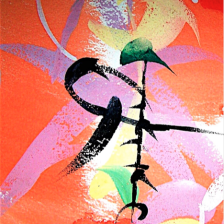
Combined etching technique; six colors
36 x 24 in. Ed. 25 CR #223
photo by the Indianapolis Museum of Art
In 1963 [Peterdi] took part in a seminar held at the University of Alaska in Fairbanks. From this vantage point he flew over the Arctic regions with one of the indomitable bush pilots. This was an entirely new experience in landscape, where great flat icecaps glistened with a hard blue light and where the only sound was the boom of the ice sheets breaking … More than a year later the colors and mood of the northern landscape began to appear in Peterdi’s paintings and prints. … (Una E. Johnson, Gabor Peterdi: Graphics 1939–1969, Touchstone Publishers, Ltd • New York ©1970)
“In April of 1963, … [he visited] Anchorage, Nome, Kotzebue, and Point Hope with former student Danny Pierce. Over the following two years, he worked on paintings and prints related to his Arctic experience.” (Wikipedia)




